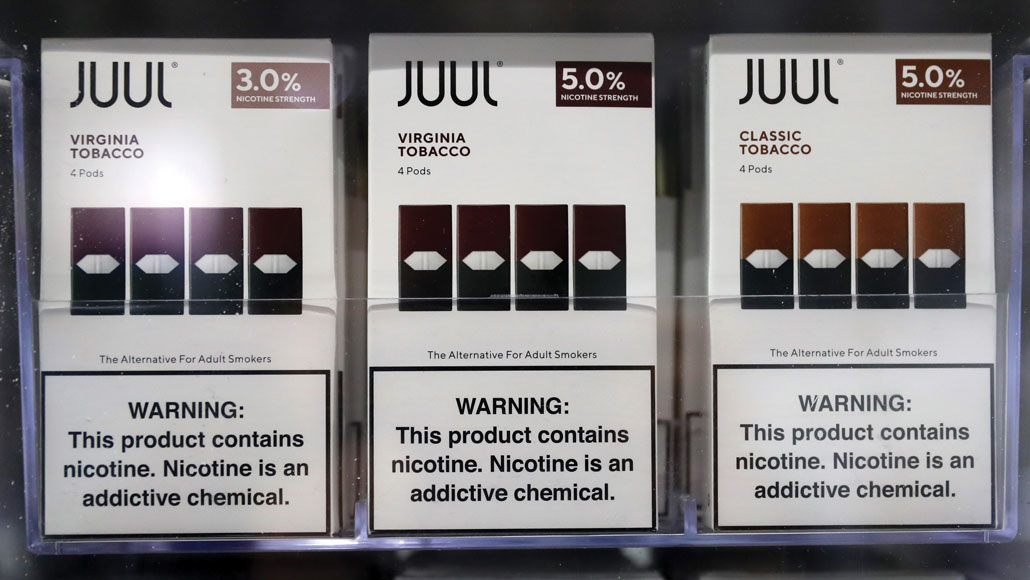Vaping’s dangers loom large amid more than 50 U.S. deaths this year
Lung illnesses highlight the dangers of e-cigarettes as teen use continues to rise

The maker of Juul, the e-cigarette most popular with teen vapers, announced in the fall that it will stop selling pods of many of its flavors, such as mango, cucumber and mint. Tobacco flavors, such as those depicted here, as well as menthol are still available.
Justin Sullivan/Getty Images
- More than 2 years ago
E-cigarettes have enjoyed a reputation of being relatively harmless, at least among the public. But that began to change in 2019, when the first reported lung injuries and deaths linked to vaping provided a stark corrective. As of December 10, a total of 2,409 people from across the United States, many of whom were young and otherwise healthy, have been hospitalized, according to the U.S. Centers for Disease Control and Prevention. And 52 people, including a 17-year-old, have died.
Federal health officials have announced a potential culprit: vitamin E acetate (SN Online: 11/8/19), added mainly as a thickening agent in vaping products containing THC, or tetrahydrocannabinol, the compound in marijuana that produces the high. Vapers should avoid THC, officials say, but the investigation is ongoing, and the illnesses may be due to more than one vaping ingredient.
Whatever the final word on this type of lung injury, dubbed EVALI for “e-cigarette, or vaping, product use associated lung injury,” it won’t be the end of the story on the dangers of e-cigarettes. An ever-rising tide of U.S. teens are vaping, and their experiences will reveal the long-term effects of e-cigarette use.
“While of course these lung injuries related to vaping are very serious, it really is just the tip of the iceberg,” says Susan Walley, a pediatrician at the University of Alabama at Birmingham School of Medicine. “The millions of kids who are using e-cigarettes now … what’s going to happen to all those kids in 10 years?”
New level of worry
The CDC is investigating a rash of lung injuries and deaths tied to the use of e-cigarettes.
2,409
people
hospitalized due to lung damage
52
deaths
in 26 states and Washington, D.C.
Source: CDC, as of December 10, 2019
The association of EVALI cases with THC may bring a false sense of security to those who vape nicotine. But even if it’s not tied to these lung injuries, nicotine is addicting a whole generation of adolescent e-cigarette users, putting them at risk for a wide range of harms, health officials say.
Studies suggest that the chemicals inhaled while vaping affect the brain, the heart and the lungs. Nicotine alters teens’ brain development, increasing the risk of addiction to other drugs (SN: 3/7/15, p. 12). Exposure to the chemicals in e-cigarettes impairs the function of the cells that line blood vessels, which could boost the risk of cardiovascular disease. And teens who vape are at higher risk of chronic respiratory symptoms than their nonvaping peers (SN Online: 8/2/19). It will take time to uncover how vaping affects long-term health; e-cigarettes have been on the market in the United States for only about a decade, and the technology has changed rapidly.
Sign up for our newsletter
We summarize the week's scientific breakthroughs every Thursday.
Meanwhile, the pace at which teens — drawn in by fruit and candy flavors and then hooked on nicotine — are becoming e-cigarette users hasn’t slowed. The National Youth Tobacco Survey found that 27.5 percent of U.S. high school students reported in 2019 using e-cigarettes in the last 30 days, up from 20.8 percent in 2018. More alarmingly, another youth survey reported this year revealed that nearly 12 percent of high school seniors and 7 percent of sophomores use nicotine vapes daily, suggesting addiction (SN Online: 9/18/19).
Nicotine in the pods used with Juul, the top-selling brand of e-cigarettes, is formulated to be less harsh than what’s found in most combustible cigarettes. “It’s not painful to inhale,” says primary care pediatrician Susanne Tanski of the Dartmouth Geisel School of Medicine in Hanover, N.H. Young people “are taking these large hits of nicotine,” she says, and more of these teens report that they’re highly addicted, even waking up at night to vape.
On the rise
The ranks of vaping high school students have swelled in the last two years in the United States, tracking the rise in popularity of the Juul brand of e-cigarettes.
Use of e-cigarettes among U.S. high school students


Source: National Youth Tobacco Survey
A person who inhales the full amount of nicotine contained in a 5 percent nicotine Juul pod gets what a smoker would take in from a pack and a half to two packs of cigarettes (SN: 12/22/18 & 1/5/19, p. 28). The device’s design — it looks like a flash drive and doesn’t produce the large plumes typically associated with other e-cigarettes — makes it easy to take discreet hits throughout the day.
To curb the epidemic of teen vapers, some states announced bans on some vape flavors. A few states are suing Juul Labs, alleging that the company used deceptive marketing practices to lure teens as customers. This fall, Juul Labs announced that it will cease sales of most of its flavored pods, including mango and mint. Those are the two top flavors used by adolescents, researchers reported in November in JAMA.







